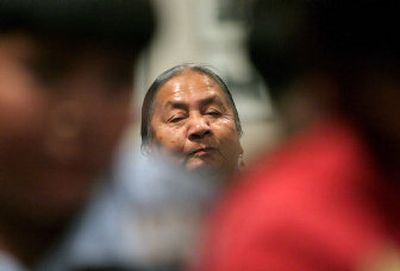Treaties’ history on exhibit

In May 1855, Allen Pinkham’s ancestors arrived in Walla Walla for treaty negotiations with territorial Gov. Isaacs Stevens. A sketch by frontier artist Gustavus Sohon captured the scene: In a display of might, hundreds of Nez Perce Indians on horseback circled the small band of government officials.
In the tense two weeks that followed, the Nez Perce would cede hundreds of thousands of acres to the U.S. government in return for a reservation that covered a fraction of their original homelands. Through shrewd negotiations, they retained rights to fish, hunt and dig for roots over a much larger area.
The Treaty Trail, an exhibit that runs through Friday at the University of Idaho, commemorates the 150th anniversary of treaties signed with Nez Perce, Yakama and Umatilla tribes. Pinkham and other tribal leaders reflected on the treaties’ legacies this week.
Indians signed the treaties in acknowledgement that the steady trickle of white settlers flowing over the Rockies would only grow larger, said Pinkham, the 67-year-old retired chairman of the Nez Perce Tribe. “By 1855, we knew what was happening. The eastern tribes were disposed and killed by war and suffering from smallpox. … Certain things we put in the treaties, thinking of our children, our grandchildren and our great-grandchildren and survival.”
Nez Perce tribal attorney Julie Kane urges later generations not to second-guess their actions. “You don’t know what the circumstances were at the time. You don’t know how their backs were up against the walls.”
In 13 months, Northwest Indians were forced to give up millions of acres of land, stretching from northern Oregon to the Canadian border, and from east of the Rockies to the Pacific Coast.
The instrument of change was 10 tribal treaties, negotiated by Stevens, which secured the land for U.S. expansion. The treaties ultimately affect everyone in the Northwest, because they became the basis of private property rights, the Treaty Trail exhibit notes.
Through Sohon’s drawings, official government minutes, and commentary, the exhibit tells the story of the negotiations. On Wednesday evening, Nez Perce drummers added another touch, filling UI’s Administration Auditorium with ancient songs sung at the negotiations.
By 1853, when Stevens arrived in the Puget Sound area, settlers were already pouring into the Northwest. The Oregon Donation Act had granted 320 acres to homesteaders – 640 acres to couples – if they farmed it for four years. But without treaties, the titles to the land were in question.
Stevens held 11 treaty councils with Northwest tribes between 1854 and 1856, securing rights to Indian land in exchange for goods and promises of schools and education. The government’s goal was to relocate all Indians east of Puget Sound and turn them into farmers.
“We’re at the sixth and seventh generation of people who struggled with this treaty time,” said Alvina Heusties, a Umatilla tribal elder. “The treaty was to wipe us out, remove us. That was what it was about. True extermination.”
By the time Stevens invited the Cayuse, Nez Perce, Walla Walla and Yakama Indians to a treaty council in Walla Walla in May 1855, the tribes were wary. They knew from Western Washington tribes that the negotiations were difficult to follow, so they brought their own interpreters.
Tribal chiefs were deeply divided over signing the treaties, the exhibit notes. Some thought it was the only way to ensure survival. Others threatened war. A Nez Perce chief, Lookinglass, was buffalo hunting, and arrived after the treaty had been signed. “My people, what have you done? While I was gone, you sold my country,” he told the other chiefs.
Stickus, a Cayuse chief, also offered a powerful lament: “If your mother were here in this country who gave you birth (and) … some people came and sold your mother, how would you feel then?”
But through the treaties, the tribes retained the rights to fish, hunt and gather roots at “usual and accustomed places.” The rights, the subject of numerous court battles, are critical to the continuation of tribal cultural and spiritual practices, Pinkham said.
During the 1930s, when Ron Halfmoon was growing up on the Umatilla Indian Reservation in northeast Oregon, his family dug for roots in Idaho and hunted for elk in the Blue Mountains. They also fished for salmon at the mighty Celilo Falls on the Columbia River, which were later flooded by The Dalles Dam.
It was a more hospitable era, said Halfmoon, a former Umatilla tribal chairman. Over time, “the land was fenced and farmed … and we were not welcome across the fence lines.”
His father was later arrested for salmon fishing in Oregon’s Wallowa Valley without a permit. When a local judge, recognizing Indian fishing rights, threw out the case and required a game warden to return confiscated fishing gear, the warden was so angry he flung the gaff hooks on the ground, Halfmoon said. Halfmoon’s wife, Loretta, became a fishing activist on the Columbia River. She was also arrested and jailed.
In 1974, a ruling by federal Judge George Boldt reaffirmed the rights of Indian tribes to fish in “usual and accustomed places.” The decision allocated 50 percent of the annual catch to treaty tribes, and it became one of the most significant Northwest cases involving treaty law. “Under the Boldt decision, the treaties were to be read as tribal negotiators would have understood them,” the exhibit said.
The next U.S. Supreme Court nominee will be critical for the future of hunting and fishing rights, said Tonia Garcia, a Nez Perce tribal member.
“The Republicans and the Right have generally not been friends to Native Americans and upholding their rights.”
In 1999, Garcia said, it was only by a narrow margin that the Supreme Court upheld the Chippewa Tribe’s rights to off-reservation resources. With the new nominee, the court balance could shift, she said.
“Our rights were not something that was given to us. They were retained rights. We were self-governing long before European contact,” Garcia said.